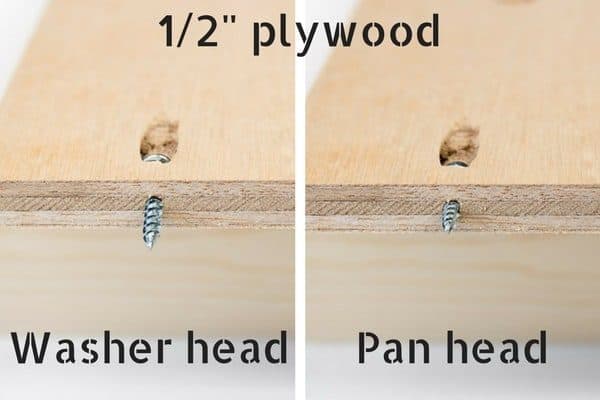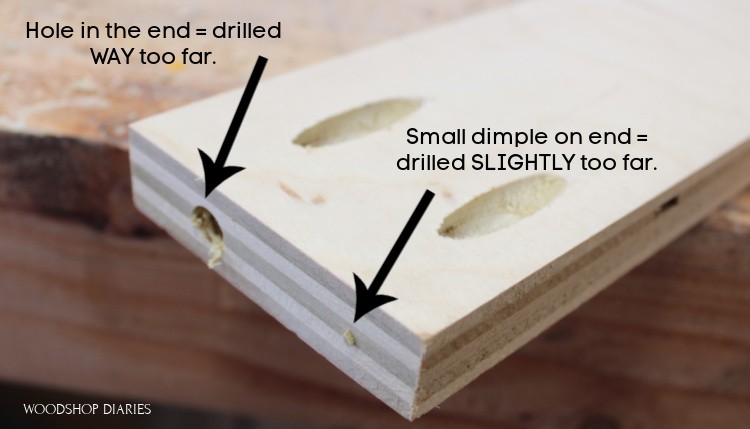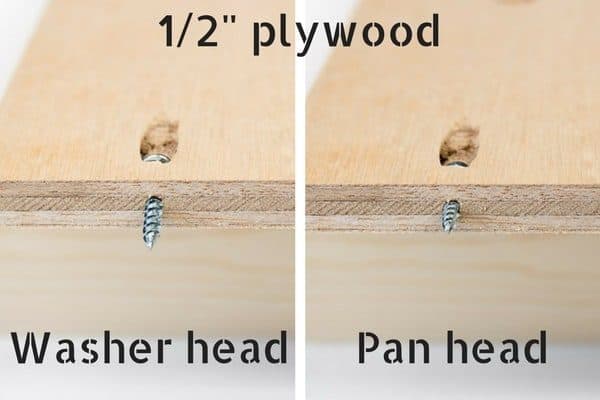Do pocket holes work in plywood? If you’ve ever tackled a woodworking project, you may have come across this question. Well, my friend, you’re in the right place because today we’re diving into the fascinating world of pocket holes and plywood. So, grab your toolbelt and let’s get started!
Now, you might be wondering what pocket holes are and why they matter. Picture this: you’re building a cabinet or a shelf, and you want a clean and sturdy joint that’s also easy to assemble. Enter pocket holes! These nifty little holes are drilled at an angle and allow you to join pieces of wood together effortlessly. They’re like the secret handshake of woodworking!
But here’s the million-dollar question: do pocket holes work in plywood? Plywood, with its layers of wood glued together, can pose some challenges for traditional joinery methods. So, we’re here to explore whether pocket holes are up to the task. Get ready to uncover the truth behind this woodworking mystery and discover some handy tips and tricks along the way. Let’s jump in!

Do Pocket Holes Work in Plywood?: A Comprehensive Guide
Pocket holes have become a popular joinery technique in woodworking projects. However, when it comes to plywood, there may be some concerns about whether pocket holes are effective. In this article, we will delve into the world of pocket holes and plywood to determine if this method is suitable and reliable for plywood projects. Whether you’re a beginner or an experienced woodworker, this guide will provide you with the information you need to make an informed decision.
The Basics of Pocket Holes
Pocket holes are a type of joinery that involves creating angled holes and using specialized screws to secure two pieces of wood together. This technique offers several advantages, including speed, ease of use, and a strong joint. The pocket holes are typically drilled at a steep angle, allowing the screws to be concealed within the joint, resulting in a clean and professional finish.
However, when it comes to plywood, there are some factors to consider. Plywood is made up of multiple layers of thin wood veneers bonded together, and the layers are prone to splitting when drilled. Additionally, the pocket hole screws may not have enough material to grip onto, leading to a weaker joint. Let’s explore these concerns further in the following sections.
Can Pocket Holes Be Used in Plywood?
Despite the potential challenges, pocket holes can indeed be used in plywood projects. However, there are several considerations to keep in mind to ensure successful outcomes.
Firstly, it’s crucial to choose the right plywood for your project. Opt for higher quality plywood with thick veneers to minimize the risk of splitting. Additionally, avoid plywood with voids or areas of weakness, as these can compromise the integrity of the joint.
Secondly, adjusting the pocket hole jig settings is essential when working with plywood. Since plywood is thinner than solid wood, it may require different settings on your pocket hole jig. Experiment with different settings to find the optimal depth and angle for your plywood thickness.
Lastly, using an appropriate screw length is crucial to ensure a strong joint in plywood. The screws should be long enough to penetrate both pieces of plywood without protruding out the other side. It’s also advisable to use screws designed specifically for plywood applications, as they have a coarser thread and a reduced risk of splitting.
By taking these precautions and using the right techniques, pocket holes can indeed work effectively in plywood projects. It’s essential to test the setup on scrap pieces of plywood before committing to your final project.
Benefits and Drawbacks of Using Pocket Holes in Plywood
Like any joinery technique, pocket holes in plywood have their pros and cons. Let’s explore the benefits and drawbacks to help you decide if it’s the right choice for your project.
Benefits:
1. Speed and Ease: Pocket hole joinery is known for its simplicity and speed. It requires minimal tools and allows for quick assembly, making it an excellent choice for beginners or those with time constraints.
2. Concealed Screws: Pocket holes create a clean and visually appealing joint since the screws are hidden within the pocket holes, leaving no visible fasteners.
3. Versatility: Pocket hole joinery can be used in a wide range of applications, including building cabinets, shelves, and furniture.
Drawbacks:
1. Weakness in Thin Materials: Plywood is a thinner material compared to solid wood, and pocket holes may not provide as strong of a joint. The screws may have less material to grip onto, resulting in a weaker connection.
2. Splitting Concerns: Plywood is more prone to splitting when drilled, particularly if it has voids or weak areas. Careful consideration is needed to prevent damage to the material.
3. Appearance in Exposed Areas: While pocket holes offer a clean finish, they may not be suitable for projects where the joinery will be visible in the final product. In such cases, traditional joinery methods may be more appropriate.
With an understanding of the benefits and drawbacks, you can make an informed decision about whether to use pocket holes in your plywood projects. Consider the specific requirements of your project, including its purpose, visibility of the joinery, and anticipated load-bearing capabilities.
Tips for Using Pocket Holes in Plywood
If you decide to use pocket holes in your plywood projects, here are some tips to ensure successful outcomes:
1. Use the Right Jig: Invest in a quality pocket hole jig specifically designed for plywood. Some jigs have adjustable settings for different material thicknesses, making them ideal for plywood projects.
2. Choose the Right Screws: Select screws designed for plywood applications. These screws typically have a coarser thread and a reduced risk of splitting the plywood layers.
3. Test on Scrap Plywood: Before committing to your final project, practice your pocket hole setup on scrap plywood. This allows you to fine-tune the settings and ensure a strong joint.
4. Reinforce with Glue: To further strengthen the joint, consider adding wood glue to the pocket hole before inserting the screw. This helps create a permanent bond between the plywood layers.
5. Consider Additional Reinforcement: In projects where extra strength is required, consider incorporating other joinery methods, such as dowels or biscuits, along with pocket holes.
By following these tips, you can maximize the effectiveness of pocket holes in plywood and create strong and durable joints for your projects.
Conclusion
When it comes to using pocket holes in plywood, it’s important to consider the thickness and quality of the plywood, as well as make necessary adjustments to the pocket hole jig settings. While pocket holes can be used in plywood projects, there are some limitations and considerations to keep in mind, such as the potential for weaker joints and splitting concerns.
Overall, pocket hole joinery offers speed, ease of use, and a clean finish, making it a viable option for plywood projects. By following the tips provided and testing your setup on scrap plywood, you can ensure successful outcomes and achieve strong and reliable joints in your plywood constructions.
Key Takeaways: Do Pocket Holes Work in Plywood?
- Yes, pocket holes can work well in plywood if done properly.
- Using the correct pocket hole jig and setting the right drill bit depth is essential.
- Plywood with a thickness of 1/2 inch or more is recommended for pocket holes.
- Applying glue along with pocket screws can enhance the strength of the joint in plywood.
- Consider using pocket hole plugs to cover the visible holes on the plywood surface.
Frequently Asked Questions
Are you wondering if pocket holes work in plywood? We’ve got you covered with answers to some common questions about using pocket holes in this type of material. Read on to find out more!
1. Can I use pocket holes in plywood?
Absolutely! Pocket holes can be used in plywood, and they are a popular choice for joining pieces together. Plywood is actually a great material for pocket holes because its layered construction provides stability and strength. Just make sure you use the right screws and adjust your pocket hole jig settings accordingly.
When using pocket holes in plywood, it’s important to remember a few things. First, choose the appropriate size and length of screws for your plywood thickness. Additionally, adjust the pocket hole jig to the thickness of your plywood to ensure a proper fit. Lastly, be mindful of the placement and spacing of your pocket holes to distribute the load evenly and prevent splitting.
2. Will pocket hole joinery hold up well in plywood?
Yes, pocket hole joinery can hold up well in plywood when done correctly. Plywood offers good screw-holding capabilities, which means that the screws used in pocket holes will grip the material securely. However, it’s important to consider the thickness and type of plywood you’re using as it can impact the overall strength of the joint.
To ensure the longevity and strength of your pocket hole joints in plywood, it’s advisable to use plywood that is at least 1/2 inch thick or more. Thicker plywood provides better structural support for the pocket screws. Additionally, using quality pocket hole screws and applying enough pressure during assembly will help create a durable joint that can withstand everyday use.
3. Are pocket holes a reliable method for joining plywood?
Yes, pocket holes are generally considered a reliable method for joining plywood. They offer several advantages such as ease of use, speed of assembly, and a strong connection. However, it’s crucial to use the right techniques and tools to ensure a reliable joint.
When using pocket holes to join plywood, it’s recommended to use a pocket hole jig and clamp the pieces together during assembly. This will help ensure accurate and secure pocket hole placement. Additionally, applying glue to the joint along with the pocket screws will further enhance the strength and reliability of the connection.
4. Can I use pocket holes to join thin plywood?
Yes, pocket holes can be used to join thin plywood. However, you need to be cautious and take some additional steps to ensure a reliable joint. Thin plywood, typically less than 1/2 inch thick, may not provide as much material for the pocket screws to grip.
If you plan to use pocket holes with thin plywood, consider reinforcing the joint using other methods such as applying glue or adding additional support, like dowels or biscuits. This will help compensate for the limited material thickness and create a stronger connection.
5. Do pocket hole joints require any additional reinforcement in plywood?
In most cases, pocket hole joints in plywood do not require any additional reinforcement. When properly executed, pocket holes provide strong and reliable connections. However, if you’re working on projects with higher load-bearing requirements or where additional strength is desired, you can consider reinforcing the joints with other methods.
Options for reinforcing pocket hole joints in plywood include using glue in conjunction with screws, adding bracing or additional support, or even incorporating other joinery methods such as dowels or splines. These additional reinforcements can further enhance the overall strength and stability of the joint, particularly in applications where the pocket hole joint will be subjected to heavy-duty use.

When to NOT use pocket screws… and when you SHOULD! | Evening Woodworker
Summary
So, do pocket holes work in plywood? The answer is yes! Pocket holes are a great option for joining plywood together because they provide strong and reliable connections.
Using pocket holes is simple – just drill a hole at an angle, insert a screw, and you’re done. It’s a quick and efficient way to assemble plywood projects.
However, there are a few things to keep in mind. Make sure to use the right size of pocket hole screws for the thickness of your plywood. Also, consider adding some glue for added strength.
Overall, pocket holes are an excellent choice for working with plywood. They make projects easier and help create sturdy and long-lasting structures. So go ahead, give pocket holes a try in your next plywood project!
